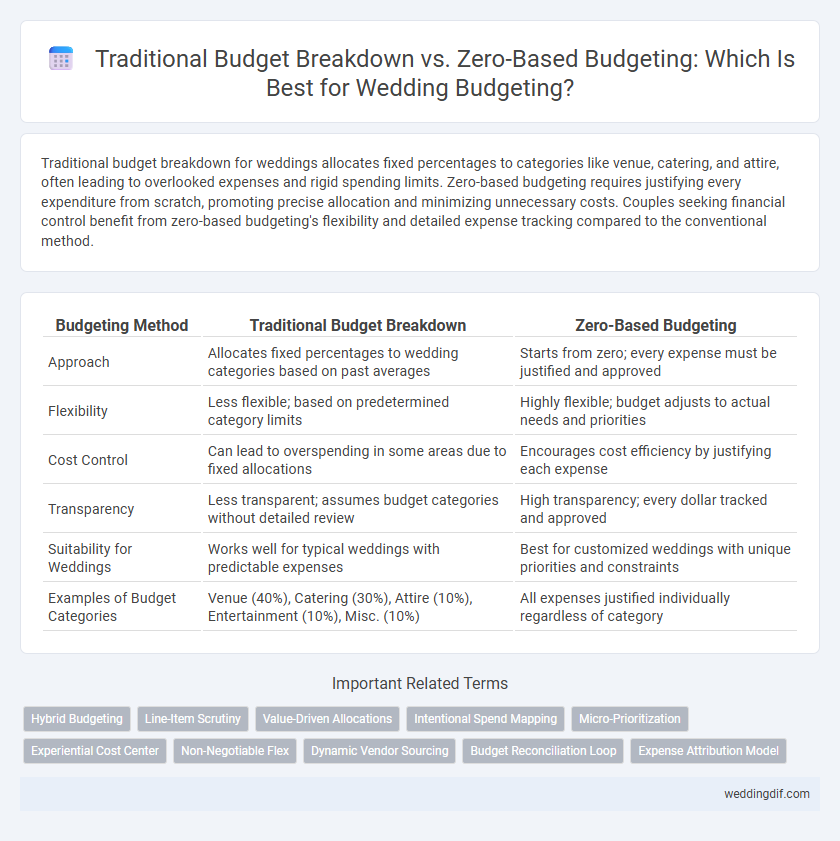Traditional budget breakdown for weddings allocates fixed percentages to categories like venue, catering, and attire, often leading to overlooked expenses and rigid spending limits. Zero-based budgeting requires justifying every expenditure from scratch, promoting precise allocation and minimizing unnecessary costs. Couples seeking financial control benefit from zero-based budgeting's flexibility and detailed expense tracking compared to the conventional method.
Table of Comparison
| Budgeting Method | Traditional Budget Breakdown | Zero-Based Budgeting |
|---|---|---|
| Approach | Allocates fixed percentages to wedding categories based on past averages | Starts from zero; every expense must be justified and approved |
| Flexibility | Less flexible; based on predetermined category limits | Highly flexible; budget adjusts to actual needs and priorities |
| Cost Control | Can lead to overspending in some areas due to fixed allocations | Encourages cost efficiency by justifying each expense |
| Transparency | Less transparent; assumes budget categories without detailed review | High transparency; every dollar tracked and approved |
| Suitability for Weddings | Works well for typical weddings with predictable expenses | Best for customized weddings with unique priorities and constraints |
| Examples of Budget Categories | Venue (40%), Catering (30%), Attire (10%), Entertainment (10%), Misc. (10%) | All expenses justified individually regardless of category |
Introduction to Wedding Budgeting Approaches
Traditional budget breakdowns allocate fixed percentages of the total wedding cost to categories such as venue, catering, and attire based on historical averages, offering a straightforward framework. Zero-based budgeting requires couples to justify every expense from scratch, promoting detailed scrutiny of each cost element to align spending tightly with priorities. This approach fosters more personalized and potentially cost-effective wedding planning by focusing on actual needs rather than preset limits.
What Is Traditional Wedding Budget Breakdown?
Traditional wedding budget breakdown allocates fixed percentages of the total budget to major categories such as venue, catering, attire, and entertainment, typically following established industry standards. This method provides a clear, structured approach that prioritizes common expenses, often dedicating around 40% to venue and catering combined. It emphasizes predictability but may lack flexibility to adjust for unique preferences or unexpected costs.
Understanding Zero-Based Budgeting for Weddings
Zero-based budgeting for weddings requires allocating every dollar from scratch, focusing on actual needs and priorities rather than relying on previous spending patterns. This method promotes meticulous planning by justifying each expense, helping couples avoid overspending and ensuring funds are directed toward meaningful elements such as venue, catering, and attire. Understanding zero-based budgeting empowers couples to create a customized wedding budget that reflects their unique vision and financial constraints.
Key Differences Between Traditional and Zero-Based Wedding Budgeting
Traditional wedding budgeting allocates funds based on previous event expenses, often using fixed percentages for categories like venue, catering, and decor, which may lead to overspending on less prioritized areas. Zero-based wedding budgeting starts from zero, requiring couples to justify every expense, ensuring every dollar aligns closely with current priorities and actual needs. This approach enhances financial control and flexibility, promoting cost-efficiency by preventing automatic carryovers of past budget line items.
Pros and Cons: Traditional Budget Breakdown
Traditional budget breakdown for weddings provides a clear, historical framework based on average expenses across major categories such as venue, catering, and attire, allowing for easier allocation and comparison. However, it may lack flexibility and can lead to overspending in less critical areas due to fixed percentage allocations and assumptions based on past events. This method often limits customization, potentially overlooking unique priorities or cost-saving opportunities specific to the couple's preferences.
Pros and Cons: Zero-Based Wedding Budgeting
Zero-based wedding budgeting requires allocating every dollar to specific wedding expenses from scratch, promoting precise cost control and minimizing unnecessary spending compared to traditional budget breakdowns. This approach enhances financial clarity and flexibility, ensuring funds are only assigned based on current priorities rather than past patterns. However, it demands more time and detailed planning, which may overwhelm couples seeking a straightforward budgeting process.
How to Build a Traditional Wedding Budget
Building a traditional wedding budget involves allocating fixed percentages of the total budget to key categories such as venue, catering, attire, and entertainment, based on historical spending patterns. This method prioritizes predictable expenses and allows for straightforward tracking by setting limits aligned with average industry costs, such as dedicating around 40% to venue and catering combined. Couples typically establish contingency funds within the traditional budget to manage unforeseen costs without redesigning the entire financial plan.
Step-by-Step Guide to Zero-Based Wedding Budgeting
Zero-based wedding budgeting starts by assigning every dollar a specific purpose, ensuring no funds are wasted. Begin by listing all wedding expenses from venue and catering to attire and decorations, then allocate funds for each based on current priorities rather than historical spending. This method allows couples to optimize their budget precisely, improving financial control and reducing unnecessary costs.
Which Budgeting Method Fits Your Wedding Vision?
Traditional budget breakdown allocates fixed percentages to categories like venue, catering, and attire based on historical averages, offering simplicity and predictability for classic weddings. Zero-based budgeting starts from a clean slate, justifying every expense according to its importance, ideal for couples seeking a tailored, cost-conscious celebration with personalized priorities. Choosing between these methods depends on whether you prefer structured financial guidelines or customized spending aligned with your unique wedding vision.
Tips for Successfully Managing Your Wedding Budget
Prioritize essential wedding elements by categorizing expenses into fixed and variable costs for a clear traditional budget breakdown, ensuring funds align with your vision. Implement zero-based budgeting by justifying every expense from scratch, helping to eliminate unnecessary spending and maximize value for key aspects like venue, catering, and attire. Track all transactions meticulously and regularly review your budget to adapt to changes while maintaining financial control and transparency throughout the planning process.
Traditional Budget Breakdown vs Zero-Based Budgeting for weddings Infographic

 weddingdif.com
weddingdif.com